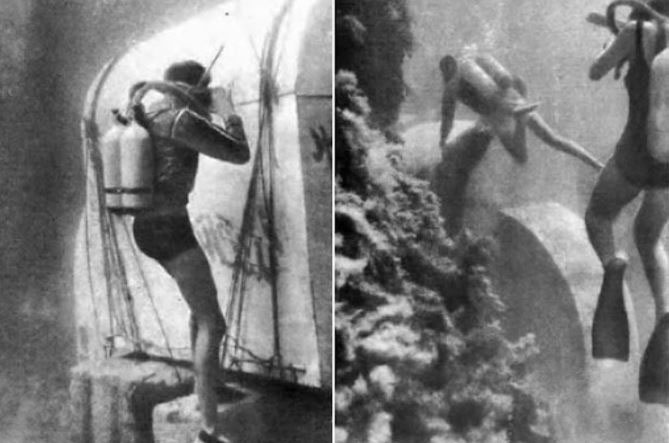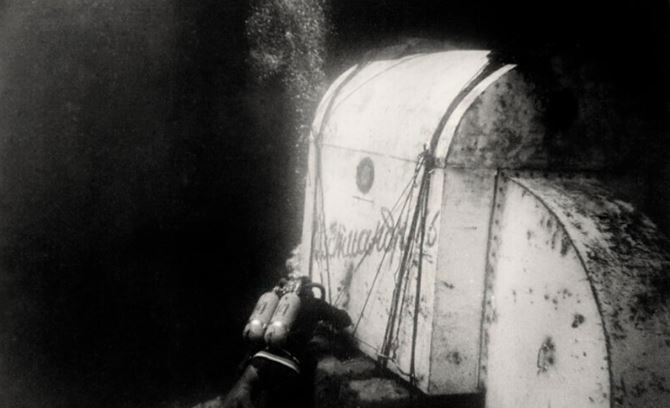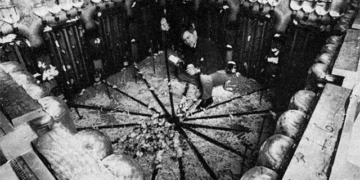The First Experiments in Human Underwater Living Were Conducted in the Crimea Region of the Former Soviet Union.
“The first day underwater. Right in front of me is a rock, covered with bushes. It is teeming with life. The crab Mitka is nestled in a rock crevice. Occasionally, he leaves his hiding spot, climbs onto the rock dramatically, and is always munching on something while waiting. Night falls. Flashes ignite from another window. They are glowing microorganisms,” diver Alexander Haes – the first resident of the underwater house in the Soviet Union – wrote in his diary in August 1966.

Some images from the first experiment. (Photo: RBTH).
In the 1960s, the Soviet Union was eager to explore not only the vastness of space but also the depths of the ocean. Divers from Donetsk were the pioneers of underwater living experiments. They were inspired by the successful experiments of the famous French explorer Jacques-Yves Cousteau. In 1962, he deployed the world’s first underwater house called “Conshelf I” to the seabed. A year later, he built an entire village in the Red Sea.
Building Houses from Scrap
While in the West, the construction and testing of underwater houses were carried out by professionals, in the Soviet Union, the initial efforts were made by an amateur team. These were members of the “Ichthyander” diving club, named after a character in the science fiction novel “The Amphibian Man” by Soviet author Alexander Belyaev.
They began assembling the underwater house in the fall of 1965 from metal scraps and old equipment, even discarded waste.

The Ichthyander 66 underwater house. (Photo: RBTH)
The first underwater house in the Soviet Union resembled a small hangar with a dome-shaped roof. Its area was six square meters, enough to accommodate two people. Inside, there was a bunk bed, a table with a telephone, monitoring equipment, medical supplies, and a toilet. Four windows allowed for views outside. The ventilation system was designed so that divers using oxygen tanks could smoke from inside.
According to the plan, electricity, fresh water, and air would be pumped from the shore through pipes and cables. A 5,000-calorie daily ration was delivered by other divers.
On August 5, 1966, this specially designed house was transported to Cape Tarkhankut in Crimea. On the cape, the project team set up a tent for 100 people. Engineers and rescue staff were always on standby onshore to ensure the experiment would proceed safely. Doctors monitored the breathing, blood circulation, metabolism, and mental responses of the divers. Meanwhile, news film crews recorded this historic moment. In total, three pioneering divers lived underwater.
High Precision Required
The first attempt to lower the house to a depth of 11 meters below sea level with the help of five half-ton concrete blocks was initiated on August 19. However, a three-day storm swept through the bay, disrupting the plan. The second attempt on August 23 was successful.
The president of the “Ichthyander” diving club, surgeon Alexander Haes, became the first resident of the underwater house. He was accompanied to the depths by his colleague Zhora Tunin. On the first day, Haes was alone.
“The house shook all night. Several times I woke up in terror. I lost my sense of space; sometimes it seemed like the cables were about to snap, and I had to rush to find an escape route, but where was it, from which direction? How could I find the rock where the emergency diving equipment was hidden? Each time, I anxiously called back to base, but a confident voice always replied: ‘Sasha, everything is perfectly fine.’ Now there’s no doubt. Our experiment has been successful,” Alexander Haes recounted in his diary.
At 7:30 AM on August 24, Haes was examined by doctors who checked his health indicators. By 8:30, a diver brought him breakfast. That evening, engineer Dmitry Galaktionov from Moscow joined Haes in the house. On August 26, miner Yuri Soveto from Donetsk replaced Haes to bring him back to the surface.
Before surfacing, Dr. Haes had to undergo a decompression process in the underwater house – expelling nitrogen from his body by inhaling a mixture of oxygen and helium first, followed by pure oxygen. During the ascent, Haes stopped for the first 20 minutes at a depth of seven meters. He then continued to stop at a depth of three meters. These pauses were for decompression – the gradual elimination of excess nitrogen from the body. After 60 minutes of recovery on the surface, the first “ocean traveler” of the Soviet Union was healthy again after three days underwater.
The next day (August 27), a storm approached. At 8 AM, doctors descended to check the health of the two “travelers” Galaktionov and Sovetov. However, by 2 PM, they decided to cancel the entire experiment.
When the “Ichthyander” project team returned to Donetsk, they received late notification from the Underwater Sports Federation about the ban on the experiment. Nevertheless, a few months later, the Federation awarded diplomas to the divers.

Model of the Ichthyander 67 house. (Photo: TASS)
Subsequent Experiments
The Ichthyander 66 project marked the beginning of a series of underwater living experiments conducted by divers from Donetsk. On August 28, 1967, once again in Crimea, they lowered the Ichthyander-67 house to a depth of 12 meters. This house consisted of four rooms designed to accommodate five people, featuring a kitchen, a bedroom, a bathroom, and a laboratory. The “travelers” lived underwater for a total of 14 days in shifts. Their goal was to test how the human body would react in an unnatural living environment. They also brought guinea pigs, rabbits, and cats to the seabed. The divers were also inadvertently tested mentally during two incidents of water leaking into the house.
The Ichthyander Underwater House was finally submerged in 1968 in Laspi Bay. The purpose this time was to conduct geological research: an active drilling rig was not far from the divers’ house. This project was suspended after four days due to the impact of a storm. And that was the last experiment of the amateur divers from the Soviet Union.

Ichthyander 68 House. (Photo: RBTH).
In 1970, a commemorative plaque for the first underwater house in the Soviet Union was erected at Cape Tarkhankut, inscribed with: “Look straight ahead and do not look back.” In 2006, 40 years after the first experiment, three black-and-white painted boxes were installed nearby to symbolize the shape of the second Ichthyander house.


















































